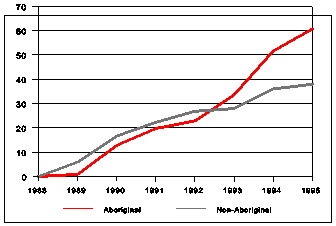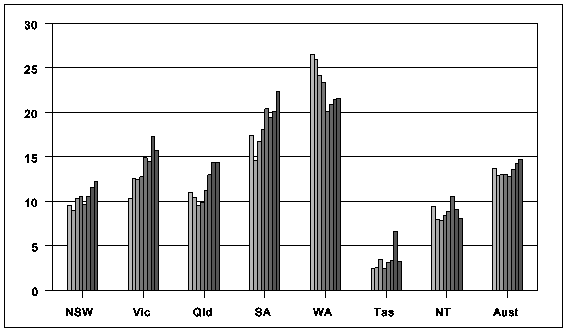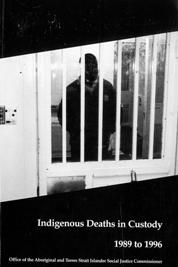Indigenous Deaths in Custody: Arrest, Imprisonment and Most Serious Offence
Indigenous Deaths in Custody
Part B - Statistical AnalysisChapter 2. Indigenous Deaths in Custody Chapter 4
Summary
IntroductionAboriginal people continued to be arrested and imprisoned at unacceptably high rates during the 1990-1995 period. These rates have increased, not decreased, since the Royal Commission. There has also been little reduction in the numbers of Aboriginal people arrested and imprisoned for offences at the less serious end of the scale. 1. Rates of ArrestNational Police Surveys were conducted by the Australian Institute of Criminology in 1988, 1992 and 1995. Results from the 1995 survey are not yet available. Table 4.1 shows the numbers of Aboriginal and non-Aboriginal people in police custody during the month of August in 1988 and 1992. There was a decline in the number of Aboriginal and non-Aboriginal people arrested of 10.5 and 11.5 per cent between 1988 and 1992.
Table 4.1 also shows the rate of over-representation of Aboriginal and Torres Strait Islander people. This rate takes into account the different population sizes of Indigenous and non-Indigenous people.1 Nationally, Indigenous people were 28.0 times more likely to be arrested than non-Indigenous people in 1992. The over-representation rate is the highest in Western Australia where Indigenous people in 1992 were 67.9 times more likely to be arrested than non-Indigenous people. The rate is also excessively high in South Australia, Queensland and New South Wales. 2. Rates of ImprisonmentThis section provides a picture of changes in imprisonment levels, rates and over-representation from 1988 to 1995. a. Number of PrisonersThe numbers of Indigenous and non-Indigenous prisoners in each State and Territory from 1988 to 1995 are presented in Table A1 in Appendix I. These figures include both sentenced prisoners and those awaiting sentence (remand). The number of prisoners is taken on 30 June for 1988-93 and 1 July for 1994-95. The counting of prisoners for just one day has a conservative impact on the number of Aboriginal prisoners represented because Aboriginal prisoners on average serve shorter terms of actual imprisonment.2 Table A1 and Figure 4.1 show that incarceration of Aboriginal and Torres Strait Islander people in Australia increased by 61 per cent between 1988 and 1995. Incarceration of non-Indigenous people increased by 38 per cent. Imprisonment levels have increased in every jurisdiction except Tasmania. The largest increases occurred in New South Wales, South Australia and Western Australia.Figure 4.1 Increases in Imprisonment Levels 1988-95 (%) b. Rates of ImprisonmentTable A2 in Appendix I adjusts imprisonment numbers for population change. The rate of Aboriginal and non-Aboriginal prisoners for every 100,000 people in their respective adult populations (15 years and over) is shown. The rate of incarceration of Aboriginal people has risen 35 per cent between 1988 and 1995. The rate has increased 25 per cent for non-Aboriginal people. The increase is most alarming in New South Wales and South Australia. In New South Wales, there have been increases of 89 per cent and 47 per cent respectively in the rates of imprisonment for Indigenous and non-Indigenous people. In South Australia these figures were 90 per cent and 47 per cent respectively . c. Over-representation in PrisonTable 4.2 and Figure 4.2 illustrate the over-representation rate of Aboriginal and Torres Strait Islander people in prison.3 Figures quoted elsewhere differ slightly due to the use of different denominators for population estimates.4 From 1988 to 1992 the rate remained stable at an average of 13.1. This indicates that Indigenous people were 13.1 times more likely to be in prison than non-Indigenous people. From 1993 to 1995 the ratio had increased sharply each year reaching 14.7 in July 1995. Recent figures for December 1995 indicate an increase of a further 0.6. Table 4.2 Over-representation of Aboriginal Prisoners
* New South Wales figures include ACT remandees. Figure 4.2 shows the increase in over-representation rate for each jurisdiction and Australia. The greatest increases have occurred in New South Wales, Victoria, Queensland and South Australia. Figure 4.2 Over-representation by State: 1988-953. Types of OffenceThe Royal Commission compared the proportion of Indigenous and non-Indigenous people in broad offence categories. With regard to police custody, Aboriginal people during August 1988 were over-represented in the categories of public drunkenness, assault and good order offences.5 Non-Aboriginal people were more likely to be arrested for homicide and drug offences. The Royal Commission had two sources of information on prisoners. The survey of prisoners on the day of 30 June 1989 revealed that Aboriginal prisoners were more likely to be imprisoned for assault, sex offences and break and enter.6 Non-Aboriginal prisoners were more likely to have committed drug and robbery offences. Aboriginal prisoners were also disproportionately represented at the less serious end of the scale, particularly in traffic offences, good order offences, property offences and justice procedures (for example, breach of orders and fine default). A survey of sentenced prisoners conducted during the month of April 1989 provided greater information on prisoners sentenced for shorter periods. The most striking fact was that 39.5 per cent of Aboriginal sentenced prisoner receptions were for fine default compared with 19.7 per cent of non-Aboriginal receptions.7 These differences in offence categories have been confirmed by later studies.8 However, it is important to further break down offences in which Aboriginal people are over-represented, such as assault, stealing offences, good order offences and traffic offences. Such a breakdown is attempted in Table 4.3 and Tables A3 and A4 in Appendix I but it is limited by the generality of many offence codes. a. Police CustodyThe Australian Institute of Criminology has supplied figures from the 1992 National Police Custody Survey to enable disaggregation. The figures are shown in Table 4.3. Aboriginal people are under-represented in the first four offences (homicide, deal/traffic drugs, sexual assault and robbery). Aboriginal and Torres Strait Islander people are over-represented in the offence of assault. However, a different picture emerges when the offence is broken down into assault which occasions grievous bodily harm, actual bodily harm and no harm. Indigenous people are significantly over-represented at the less serious end of the scale for assault. (0.3, 4.5, 9.3 per cent) compared to (0.3, 2.1, 4.5 per cent). These differences are statistically significant.9 The Commonwealth House of Representatives Standing Committee on Aboriginal and Torres Strait Islander Affairs recently criticised ‘provocative policing’ practices which result in what is colloquially known as the trifecta: offensive language, resisting arrest and assaulting police.10 The latter charge will usually involve no harm. As assault occasioning no harm is the most serious offence for 9.3 per cent of Indigenous detainees (twice the percentage of non-Indigenous people in this category) it raises questions as to the continuing use of this practice even in jurisdictions where offensive language is no longer an imprisonable offence. The other indicator of trifecta-style policing is property damage. A recent study found that between 1990 and 1992 the only people imprisoned in New South Wales for malicious damage were Indigenous.11 Table 4.3a indicates that a higher number of Aboriginal and Torres Strait Islander people were arrested for the offence of property damage. For further discussion on the trifecta, see Chapter 6 (recommendation 86 and 87) and Chapter 9 (recommendation 92). Aboriginal and Torres Strait Islander people are also over-represented in the offence of break and enter. Unfortunately no breakdown of this offence is possible. Examination of stealing offences generally reveals that Indigenous people are more likely to be arrested for break and enter and motor vehicle theft while non-Indigenous people are more likely to be arrested for fraud and other theft. These differences are statistically significant.12 As will be discussed in chapter 9 (recommendation 92), circumstances of arrests suggest that Indigenous people are being inappropriately charged with break and enter as opposed to other stealing offences. In relation to offences against good order Indigenous people are over-represented for breaches of liquor licencing laws (2.2 to 0.4 per cent) and public drunkenness (16.7 to 14.8 per cent). Non-Indigenous people are significantly over-represented in the offence of possessing drugs. For other good order offences Aboriginal and Torres Strait Islander people are significantly over-represented (14.5 to 7 per cent). Aboriginal and Torres Strait Islander people are slightly under-represented in driving offences except for the offence of driving without a licence, for which Indigenous people are twice as likely to be arrested. See further discussion of this issue in Chapter 9 (recommendation 95). For other offences, there is no significant difference between Indigenous and non-Indigenous people.
b. PrisonersTable A3 in the Appendix to this chapter shows the most serious offence for prisoners in custody on the 30 June 1995 in all jurisdictions except Western Australia and New South Wales. Although they participated in the (expensive) design of the system, these states were unable to provide disaggregated figures based on the Australian National Classification of Offences (ANCO). The most significant difference is found in the offence of assault not occasioning bodily harm (13.6 per cent to 3.8 per cent). The differences between the three assault figures are statistically significant.14 Aboriginal and Torres Strait Islander people are therefore over three times more likely to be imprisoned for assault not occasioning bodily harm. Table A3 also indicates that Indigenous people are more likely to be imprisoned for justice procedures. This is to be contrasted to Table 4.3 where Indigenous people were slightly less likely to be arrested for justice procedures. Otherwise, the differences are fairly consistent with Table 4.3. c. Deaths in CustodyTable A4 in Appendix IA shows the offences committed by Aboriginal and non-Aboriginal people who died in prison custody between May 1989 and December 1995. Disaggregation is difficult to achieve due to a smaller sample size. The figures confirm that Indigenous prisoners were three times more likely to have been imprisoned for assault occasioning no bodily harm than other prisoners (18.2 per cent to 6.1 per cent)15 and twice as likely to have been imprisoned for property damage (3.6 per cent to 1.6 per cent).
4. Length of SentenceA sentence is the way a court disposes of a case in which the accused is found to be guilty. A sentence can be a community service order, a bond, a fine, a suspended sentence, a prison term or one of a range of programmes designed to rehabilitate people who have problems with drugs or alcohol. A court can sentence an offender to be detained until the rising of the court, in which case the offender never actually goes to prison. As prison terms imposed on Indigenous offenders are on average almost a quarter less than non-Indigenous offenders, there have been suggestions that Aboriginal and Torres Strait Islander people are being treated more leniently by the courts. The conclusion has even been drawn that courts are letting Aboriginal people off to avoid accusations of racial bias against Indigenous people in sentencing.16 When all of the dispositions are considered, this conclusion is pure mistake.17 The conclusion could only be drawn if a ‘prison term equivalent’ was assigned to sentences which did not involve prison. The Royal Commission commented that shorter prison terms was due, in part, to the over-representation of Aboriginal and Torres Strait Islander people in prison for less serious offences.18 They are less likely to be granted non-custodial sentences.19 They are more likely to have greater number of charges laid against them per appearance.20 In any case, the comparison which forms the basis of the conclusion is not a meaningful one, as important matters such as degree of criminality, and factors which bring Aboriginal people before the courts where others would never be charged (greater use of public space, for example), are not considered. It also a result of the failure to divert Aboriginal and Torres Strait Islander people at the point of contact with police through to the point of sentencing. Appendix1. Rates of ImprisonmentTable A1 Numbers of Aboriginal and non-Aboriginal Prisoners*Source: Prison Census 1988-1993, Australian Institute of Criminology; National Correctional Statistics, 1994-1995, 1995, Australian Bureau of Statistics. The 1994 and 1995 figures supplied by the ABS for NSW do not include periodic detainees. Estimates of periodic detainees, derived from proportions in 1993, have been added to ABS figure to provide the number of NSW prisoners.
Table A2 Imprisonment rates per 100,000 population
2. Most Serious Offence
ENDNOTES
|
Office of the Aboriginal and Torres Strait Islander Social Justice Commissioner for theAboriginal and Torres Strait Islander Commission |
||||||||||||||||||||||||||||||||||||||||||||||||||||||||||||||||||||||||||||||||||||||||||||||||||||||||||||||||||||||||||||||||||||||||||||||||||||||||||||||||||||||||||||||||||||||||||||||||||||||||||||||||||||||||||||||||||||||||||||||||||||||||||||||||||||||||||||||||||||||||||||||||||||||||||||||||||||||||||||||||||||||||||||||||||||||||||||||||||||||||||||||||||||||||||||||||||||||||||||||||||||||||||||||||||||||||||||||||||||||||||||||||||||||||||||||||||||||||||||||||||||||||||||||||||||||||||||||||||||||||||||||||||||||||||||||||||||||||||||||||||||||||||||||||||||||||||||||||||||||||||||||||||||||||||||||||||||||||||||||||||||||||



